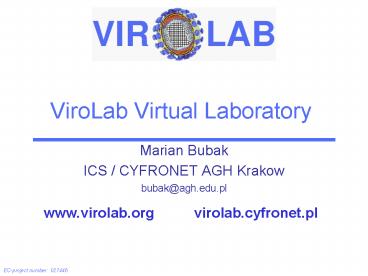ViroLab Virtual Laboratory - PowerPoint PPT Presentation
Title:
ViroLab Virtual Laboratory
Description:
Globus Toolkit, GAT. myGrid, Taverna. Drag&Drop. Globus ... Globus Toolkit, GAT. Conclusions: There is no solution that fulfills all ViroLab requirements ... – PowerPoint PPT presentation
Number of Views:52
Avg rating:3.0/5.0
Title: ViroLab Virtual Laboratory
1
ViroLab Virtual Laboratory
- Marian Bubak
- ICS / CYFRONET AGH Krakow
- bubak_at_agh.edu.pl
www.virolab.org virolab.cyfronet.pl
2
Outline
- ViroLab applications and users
- Structure of the virtual laboratory
- Challenges
- Team
3
Classes of Users
- Experiment developer (scientific programmer)
- Plans a ViroLab experiment using the VLvl
development tools - Knows both how to script an experiment and the
modelled domain - May develop dedicated UI for an experiment user
- Experiment user (research-oriented user,
scientist) - Uses prepared experiment to gather scientific
results (via Portal) - Results may be shared with others using
collaboration tools - Results provenance could be tracked and recorded
- Results may be stored in ViroLab Laboratory
Database - Medical User (clinical virologists)
- Interested mainly in meta DSS drug ranking system
- Uses dedicated web GUI (inside ViroLab Portal)
- The system may use some ViroLab applications
(Binding Affinity Calculator, rule mining, ...)
to provide better support over time, but not in
automatic way
4
Generic Use Cases
5
Requirements
- Mechanisms for user-friendly experiment creation
and execution an integrated development/executio
n environment - Possibility of reusing existing libraries, tools
etc. - Gathering and exposing provenance information
- Integration of geographically-distributed data
resources - Access to WS, WSRF, MOCCA components and jobs
- Secure access to data and applications
6
Overview of Workflow Systems and Virtual
Laboratories
- Conclusions
- There is no solution that fulfills all ViroLab
requirements - Many useful ideas have already been implemented
and ViroLab vl reuses them (in semantic modeling,
tool registry, provenance tracking etc.) - Using a scripting language for creating scripts
has turned out to be useful (Geodise) and it is
the best solution for ViroLab users
7
Virtual Laboratory layers
8
Architecture of ViroLab virtual lab
9
Status of ViroLab virtual lab
10
Available Experiments
- Developing (planning) a new experiment
- From virus genotype to drug resistance
- Provenance information about experiments
- Drug Resistance System based on the Retrogram set
of rules - Data mining and classification with Weka
- ...
11
Scientific Challenges
- Development of collaborative, multidisciplinary
applications - Abstract layer to hide technological changes
- Semantic description of applications
- Integration of provenance recording and tracking
- A new method of collaborative application
development - Constructing the virtual laboratory
- Semantic description of resources
- Deployment on available Grid systems, clusters,
and single CEs - Integration of technologies WS, WSRF,
components, jobs - Secure data access and integration
- Virtual laboratory as a complex system (formal
description, modeling, analysis, ...) - Software engineering aspects
- Exploitation of modern IT technologies
12
Technologies 1/2
- GridSphere as the user portal
- Compliant with widely accepted portlet standards
- Many portlets already available
- Eclipse RCP as the developer UI
- Tool of choice of many software developers
(including ViroLab consortium) - Industry standard with a large number of
available plug-ins, extensions - JRuby for experiment planning
- Powerful standard library combined with simple,
easy to learn syntax - Enables smooth integration with existing Java
software (including Grid software)
13
Technologies 2/2
- Middleware
- WS (for simple, stateless services with blocking
calls) - MOCCA (for stateful components and asynchronous
calls) - WSRF and Grid job submission support
- OGSA-DAI for data sources integration
- Well-developed, quite stable and under
standardization process by OGF - OWL, Jena, eXist for ontology storage and
processing of semantically-rich provenance data - Popular tools for ontology modelling
- GEMINI, Ganglia and JMX for experiment and
infrastructure monitoring - Standard, generic and extendable solutions
14
The Team
- WP3 leader Marian Bubak
- Task 3.1 Runtime
- Tomasz Gubala, Marek Kasztelnik, Piotr Nowakowski
- Task 3.2 Collaboration Tools
- Alfredo Tirado
- Task 3.3 Data Access
- Stefan Wesner, Matthias Assel, Aenne Loehden,
Bettina Krammer - Task 3.4 Provenance
- Bartosz Balis, Jakub Wach, Michal Pelczar
- Task 2.2 Middleware
- Maciej Malawski, Tomasz Bartynski, Eryk Ciepiela,
Joanna Kocot, Iwona Ryszka, Katarzyna Rycerz - Task 2.3 Presentation
- Wlodzimierz Funika, Piotr Pegiel, Dariusz Krol
15
More
- ViroLab Project web site
-
www.virolab.org - ViroLab Virtual Laboratory description, demos,
downloads, ... -
virolab.cyfronet.pl - ViroLab Session at CGW07
- www.cyfronet.krakow.pl/c
gw07

